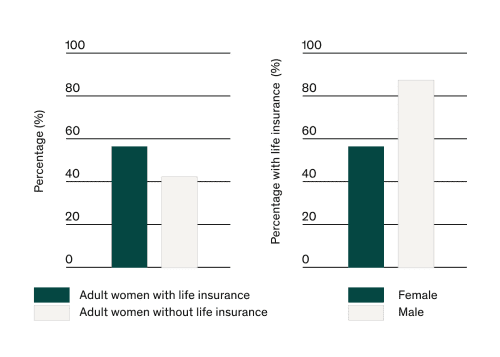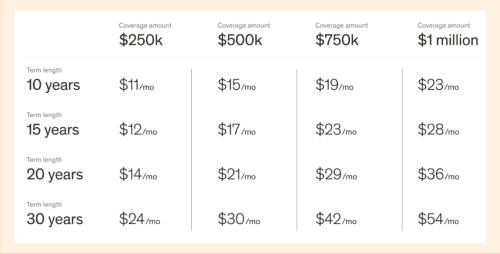Life insurance for women: What you need to know
/_Life_insurance_for_women_f2yebk.jpg)
Did you know that women are far behind men when it comes to owning life insurance? Research from the Life Insurance Marketing and Research Association (LIMRA) found that only 56% of women in the U.S. have active life insurance policies, roughly 10% less than their male counterparts (62% of men own life insurance). And of the women that do, their policies typically provide much less coverage than men’s, despite having the same needs.

What life insurance is for
The goal of life insurance is to protect your loved ones. The specific people you can name in your life insurance policy are called your beneficiaries. If you pass away while your life insurance policy is active, the death benefit that your beneficiaries would receive could help ease a number of financial burdens. That’s why no matter what they do, all women should look into their life insurance options.
The stakes are changing
According to the US Bureau of Labor Statistics (BLS), approximately 57% of women are in the workforce, and nearly 55% of married couples are dual-income households. Additionally, women are also increasingly the primary breadwinners for their family, and that includes significant rises in dual-income households over the past few decades.
Clearly, women are significant drivers for household income and finances. Now, add to that all of the other responsibilities women, especially mothers, have in the home. More often than not, women are the primary caregivers for both their children and their parents, and do much of the cooking and cleaning in married and domestic partner households. For single mothers, all of those responsibilities fall upon their shoulders.
It's a lot of work, but the value of that work is often times overlooked. That's especially true in households with a stay-at-home mother. While stay-at-home mothers aren't contributing an income from an outside place of work, the value of everything they do is significant.
For many women, that gap in life insurance coverage can have a significant impact on the family that’s left behind.
/20Q2-CMS003-02-life-insurance-case-for-coverage_2x_ovjhra.png)
Term length
When thinking about how long you will need coverage, the key is to think about the long term. Depending on your situation, you might need to replace your income or equivalent childcare costs, pay for debts, and cover funeral costs—or some combination of several expenses. You will need to ensure you are covered as long as you carry those responsibilities. For example, a stay-at-home mom with kids entering college might only need a 10-year policy while a young single woman right at the start of her career might opt to lock in a 30-year policy, so she's prepared for the future.
Coverage amount
Calculating coverage can seem tricky, but really you just need enough coverage to ensure your loved ones won't have to worry about additional expenses, such as your shared mortgage, car payments, or childcare. It can help to think about it in terms of how much income you’d bring in over the term length you select, in addition to any debt you would accrue over that same time period. For example, a single-mom makes $50K a year, but her mortgage costs her $10K annually for 10 years. She’s getting a 10-year term so she should multiply her income and debt by 20, giving her a coverage amount of $600K. If you want help getting a more detailed recommendation, try our debt and income calculators below.
Women must understand how important life insurance is for them. Even if you are a stay-at-home mom, a single mother, or the primary breadwinner for your household of one, it's critical to protect your loved ones. Life insurance can help.

The fact of the matter is, even if you get life insurance through your employer, it's often not enough for the coverage that you might need down the road.
Your employer-sponsored plan might be worth 1-2X your salary. However, experts recommend coverage that is approximately 10X your current salary. It’s also important to consider that your employer-sponsored life insurance plan might not travel with you if you change jobs or are between jobs. That’s where having a term life policy of your own can make sure you’re covered regardless of your job situation.
Having a policy in place will help ensure that if you pass unexpectedly, your loved ones will have some financial relief.
As a stay-at-home spouse, you provide a serious benefit to your family—one that would have to be paid for if you were no longer there. Your surviving spouse would need to cover costs related to child care and home management, which can certainly add up.
So, just because stay-at-home moms don't bring in outside income, it doesn't mean life insurance isn't needed.
Single moms carry the sole responsibility of providing for and taking care of their families. That means it's critical to have life insurance, especially with young dependent children.
A term life insurance policy can give you peace of mind that, if something were to happen, your children would have the financial security to get them through.
Many women live in the so-called 'sandwich generation.' These are people caring for their children as well as older parents or relatives in the form of helping to cover healthcare costs, adult daycare, or transportation.
These expenses can add up, and for the person who serves as the primary caregiver, their loss would need covering. Life insurance for caregivers can help cover some of these additional expenses without disrupting the quality of care.
Don't forget that life insurance benefits more than a spouse or children. Remember, at the very least most people have debts and funeral expenses that need to be covered. Many single women also take on the role of caretakers in their family, for an aging parent or sibling.